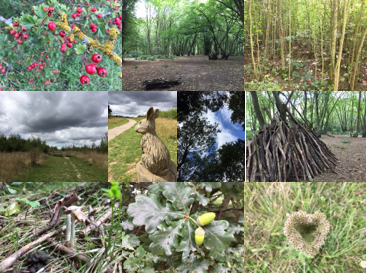Have you ever been Forest Bathing?

Last weekend I had a lovely walk around Heartwood Forest, a site owned & managed by the Woodland Trust.
Until 2008, this 347-hectare site in Hertfordshire was just agricultural land, now it makes the largest continuous new native forest in England, with 600,000 native trees planted by volunteers. In addition, there are precious pockets of ancient bluebell woodland, old hedgerows, wildflower meadows, wonderful bird life and open grassland.
I spent a couple of hours there, meandering around the trails, enjoying the woodland areas, young & old. It was a pleasure to listen to the birds, watch the squirrels, eat the blackberries, feel the breeze on my face.
Forest Bathing
At a business meeting recently, I was introduced to the concept of forest bathing.
First developed in Japan in the 1980s, ‘shinrin-yoku’ is not about wild swimming in tree-lined ponds (you don’t need to pack your swimsuit), but more about walking in woodland, slowing down and immersing yourself in the forest atmosphere.
Studies by the Japanese government showed that two hours of mindful exploration in a forest could reduce blood pressure, lower stress hormone levels and boost the immune system. This lead to it being adopted as a national health programme there.
It seems obvious that a walk in the woods is good for your physical & mental well-being. We all know that fresh air & nature are good for the soul, but I think it’s the extra concept of mindfulness that is key here – taking time to really focus on the natural world around you.
Top tips for forest bathing
I’ve taken these tips for getting the most out of your forest bathing from the National Trust.
- Try to go when there are fewer people around – early morning, later in the evening or weekdays (outside school holidays).
- Put your phone away. A digital detox helps you slow down and focus on the environment around you.
- Take your time. Walk slowly or maybe sit down to really take in your surroundings – sounds, colours, smells, the wildlife.
- Use all of your senses. Listen to the different types of birdsong, see how the sunlight pierces the leaves, feel the rough bark of a tree trunk.
- And… breathe. Close your eyes, take ten slow, deep breaths in and out, then gently open your eyes and bring your awareness back to the forest.
- Stay as long as you can. Two hours is recommended for forest bathing, but if you’ve only got 10 minutes, that’ll help you feel refreshed too.
So, please do try to get out and about for some forest bathing. Of course, it doesn’t have to be the deepest, darkest forest – not all of us are lucky to be near open forests after all. Whatever you have access to, any woods will do, or if you’re in town just try to find any green area.
Breathe. Listen. Relax. Enjoy.
_____________________
Liked this post? Sign up for the Eshcon Newsletter.

